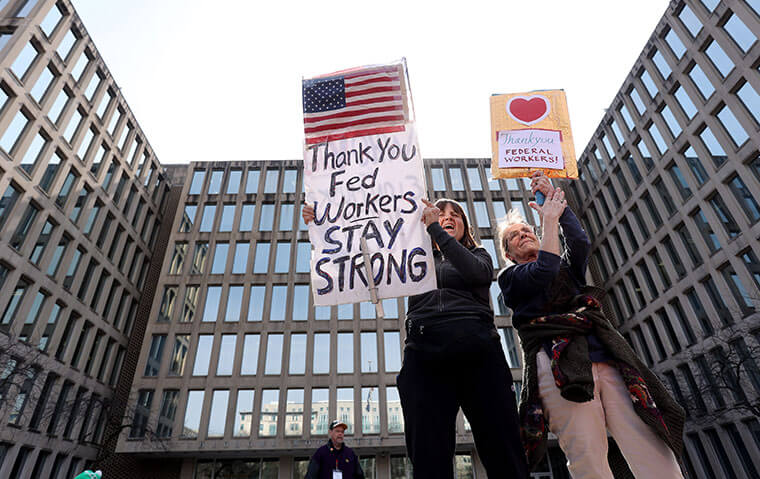 Demonstrators hold signs in solidarity with the American Federation of Government Employees of District 14, as they protest in support of federal workers at the Office of Personnel Management in Washington, DC, on March 4, 2025. Image: Gent Shkullaku/ZUMA Press Wire/Shutterstock
By: FEDweek Staff
Demonstrators hold signs in solidarity with the American Federation of Government Employees of District 14, as they protest in support of federal workers at the Office of Personnel Management in Washington, DC, on March 4, 2025. Image: Gent Shkullaku/ZUMA Press Wire/Shutterstock
By: FEDweek StaffUpdated: Two federal judges have ordered the reinstatement of many thousands of probationary employees fired by the Veterans Affairs, Agriculture, Interior, Energy, Defense, and Treasury departments, in an expansion of an earlier ruling holding that OPM had ordered the firings despite having no authority to do so.
A bench ruling by District Judge William Alsup of the U.S. District Court for Northern California is among the latest in a series of rulings against the firings, which are in the tens of thousands government-wide.
The judge earlier had ordered a pause in further layoffs at two of those departments—DoD and VA—and at several other agencies, but his new ruling on Thursday (March 13) goes beyond that pause by ordering employees returned to their jobs.
According to the AFGE union, a party to the case that represents hundreds of thousands of federal employees, the judge ordered that the departments cease further firings and provide detailed information regarding the reinstatement of those already removed.
Alsup “also forbade OPM from giving any guidance to federal agencies on which employees should be terminated” and “ordered further briefing on whether the administrative channel for fired workers is actually available, or if it has been destroyed by firings of appeals board and Office of Special Counsel personnel,” the AFGE said.
“Well established law does not permit the government to fire probationary employees without reasons based in performance or conduct. The Judge found that the Government essentially falsified its reasons for terminating these employees by claiming performance,” said Michael Fallings, a Parter at Tully Rinckey PLLC. “I think this ultimately comes down to whether the Supreme Court believes the President has power to fire employees, for whatever reason.”
Also on Thursday Maryland District Court judge James Bredar issued a temporary restraining order in response to a related, multi-state lawsuit, calling for the reinstatement of fired probationary employees.
The TRO orders defendants (it names nearly ever federal agency and the agency heads, as sued in their official capacity), to reinstate any probationary employee fired after January 20, 2025 – unless the employee was “actually terminated on the basis of a good-faith, individualized determination,” by March 17.
Agencies have until then to also file with the court status reports detailing compliance activities – including the number of employees reinstated, broken down into as granular level as possible, such as subcomponents and work units, the order stated.
MSPB Orders Remain in Place, while OSC Challenge Uncertain
The White House had ordered the firing of an MSPB member, Cathy Harris, which would have left the board without a quorum to hear appeals by federal employees challenging their firings and other personnel actions. However, in a separate suit a judge has ordered that she remain in office.
Meanwhile, the White House’s firing of Special Counsel Hampton Dellinger has taken effect. Dellinger dropped his challenge after an initial ruling against him by an appeals court. That ruling left the position in the Trump administration’s hands to fill through what would have been many more months of legal fighting.
Dellinger had sponsored two cases before the MSPB that resulted in the reinstatement at least temporarily of fired probationary employees—one a test case of one employee each from six agencies and the other involving some 5,900 laid off by the Agriculture Department.
Those orders remain in place, but Dellinger’s ouster leaves in question whether the OSC will continue to pursue them and what could have been more against other agencies.
Like the suits in the federal courts, the MSPB orders are based on arguments that OPM effectively ordered a reduction in force of those employees without authority, that the agencies conducted the RIFs outside the laws and rules governing them, and that by using boilerplate language in layoff notices, agencies did not meet requirements to inform even probationary employees of performance deficiencies before removing them.
Some laid off USDA employees likely are affected by more than one decision but sorting out the exact impact could take some time.
Further complicating matters is that at least Energy and the VA are among the agencies that already have brought back to work some probationary employees they initially fired.
In the wake of Alsup’s earlier order, OPM had rewritten a January memo to agencies on probationary employees that started the process, to insert language asserting that decisions on their continued employment were at an individual agency’s discretion.
The DoD meanwhile issued a memo afterward saying that it had made its decision to lay off some 6,000 probationers independent of OPM direction.
OPM Advises Agencies on Conducting RIFs During Shutdown
Updated Shutdown Contingency Plans Show Range of Impacts
Use Shutdown as Justification for More RIFs, OMB Tells Agencies
Unions Win a Round in Court Disputes over Anti-Representation Orders
Deferred Resignation Periods End for Many; Overall 12% Drop
Senate Bill Would Override Trump Orders against Unions
See also,
How to Handle Taxes Owed on TSP Roth Conversions? Use a Ladder
The Best Ages for Federal Employees to Retire
Best States to Retire for Federal Retirees: 2025

